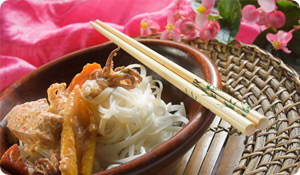
It's enough of a challenge to manage your blood sugar when you're eating at home and cooking with familiar ingredients. But when you eat in a restaurant, you may suddenly realize you have no idea what's in the food set before you.
Mexican, Thai, Italian, Japanese—all are delicious, to be sure, but they can be a potential minefield in terms of blood sugar control. So does this mean you should stay home? Definitely not!
"You can eat well and make healthy choices when you eat in an ethnic restaurant," assures Alenka Ravnik-List, RD, CDE, at the Mount Sinai Medical Center in New York City. "One rule of thumb is to fill half your plate with vegetables. Another quarter should be filled with lean protein, and the remainder of the plate with carbohydrates (preferably whole grains)."
Here's how to go on a global restaurant tour and keep your blood sugar in the normal range. Remember that restaurant portions are nearly always bigger than what you should be eating, so before you start a meal, have the waitress box up half of it to take home.
When You Eat at a Mexican Restaurant
Best Mexican Bites:
Fajitas, which typically don't include all the cheese found in a quesadilla or other dish. Eat just one and either take the leftovers home or share with a friend. Request whole wheat tortillas and substitute avocado for sour cream. Soft tacos, such as burritos, are better than crispy ones since they're cooked in less fat.
Worst Mexican Bites:
A taco salad sounds healthy, but usually comes in a big edible bowl made out of fried tortillas. Avoid dishes that are made with loads of cheese. Chips and salsa aren't recommended because it's so hard to stop eating them once you start. Instead, dip raw vegetables into salsa. Steer clear of tostadas and chimichangas, since they're fried. And avoid anything labeled "crispy" for the same reason.
When You Eat at a Thai Restaurant
Best Thai Bites:
Focus on stir-fried or sautéed dishes made with curry, lemongrass, basil, and chili.Ask for brown rice instead of white. Skewered grilled meats are usually good choices, and you can ask for sauce on the side.
Worst Thai Bites:
Fried dumplings, spring rolls and anything made with coconut milk. Pad Thai is a signature dish at Thai restaurants, but since it's primarily noodles, it should be eaten in very small portions.
When You Eat at an Italian Restaurant
Best Italian Bites:
Salads with dressings on the side for dipping. Pasta primavera, if it's made without cream and has extra vegetables. Pasta with red sauce rather than cream sauce. Request whole wheat pasta, and get half an order if available. Order pasta with a lean meat so you'll have protein on your plate as well as carbs. Order a thin-crust pizza and ask for extra vegetables as a topping.
Worst Italian Bites: />Pasta in cream sauce, cheese-filled pasta dishes like manicotti and lasagna, deep-dish meat lover's pizza, cheese-blanketed, breaded veal, chicken, or eggplant parmigiana.
When You Eat at a Japanese Restaurant
Best Japanese Bites:
Sashimi, which is just fish, can be paired with a lot of vegetables and brown rice; teriyaki dishes; and sushi rolls made with cucumbers, tofu or avocado.
Worst Japanese Bites:
Sushi rolls that are made with deep-fried fish, like shrimp; sushi rolls that are made with cream cheese; all tempura dishes, which are fried; and avoid deep-fried spring rolls.
When You Eat at a Chinese Restaurant
Best Chinese Bites:
Clear-broth soups and dishes that are steamed and have a lot of vegetables (steamed vegetable dumplings are one example). Request steamed chicken and shrimp with broccoli, or vegetables with tofu.
Worst Chinese Bites:
Chinese restaurants are known for their bountiful portions of rice and noodle dishes, so if you order one of these, be sure to divide up your portion and take at least half home. Chinese food also tends to be high in sodium; never add extra salt. Whatever you choose, always ask for extra vegetables, and if you have a choice, ask for brown rice rather than white.
When You Eat at an Indian Restaurant
Best Indian Bites:
Order dishes that are primarily legumes, as well as meats that don't have any sauce. Basmati rice is a better choice than white rice.
Worst Indian Bites: />Avoid anything made with ghee (which is clarified butter), and korma (which basically means it's made with cream).
Sources:
Ravnik-List, Adee Rasabi, RD, CDE, CDN, senior dietitian of the Ambulatory Care Network at New York Presbyterian/Weill Cornell Medical Center in New York City
Alissa Rumsey, RD, NewYork-Presbyterian/Weill Cornell Medical Center





